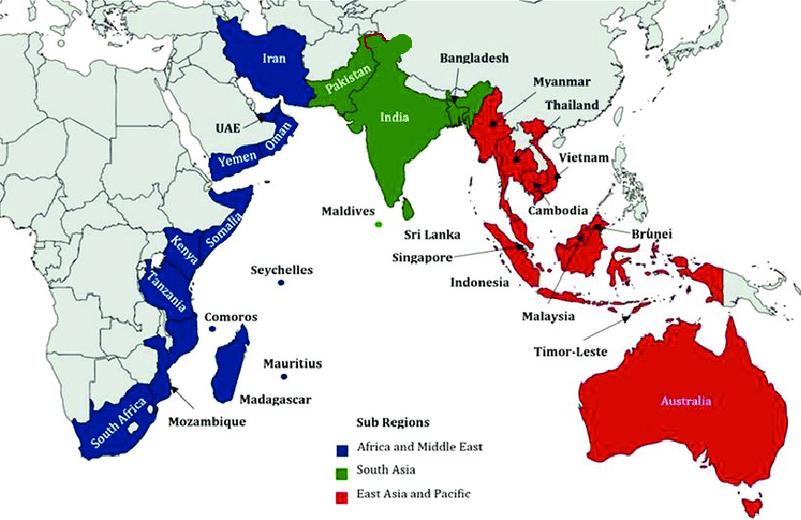
- What truly defines India’s “national interest” amidst the delicate tapestry of its neighbourhood? In an era where strategic autonomy is the currency of global power, India stands at a defining crossroads.
- As the world transitions into a tech-intensive, mineral-hungry future, the old logic of geography is fast giving way to the new calculus of global interdependence.
- While neighbours may be our first circle of engagement, are they sufficient to meet the scale and sophistication of India’s rising ambitions?
As India aspires to become a $5 trillion economy and a global manufacturing powerhouse, its appetite for technology, energy, and critical minerals is set to surge dramatically. While the “Neighbourhood First” policy remains central to India’s regional diplomacy, a pragmatic recalibration is imperative, one that looks decisively beyond the immediate periphery.
Critical minerals, for example, help reduce India’s over-reliance on imports, particularly from China, as it currently dominates global rare earth production, accounting for over 69% in 2023. This dominance extends beyond mining, with China also processing nearly 90% of the world’s rare earth elements. While China’s lower production costs and advanced refining capabilities contribute to this dominance, concerns arise from its production quotas and export restrictions. In light of the growing demand for rare earth elements (REEs), industrialised countries have started to develop strategies to reduce REE supply chain risks. The findings in the IEEFA’s report examine five critical minerals (and their compounds)— cobalt, copper, graphite, lithium, and nickel- concerning import dependency, trade dynamics, domestic availability, and global price fluctuations. It also highlights India’s continued import dependence on minerals such as lithium, cobalt, and nickel.
India’s ambitious target of 30% EV penetration by 2030 hinges on access to critical minerals for battery manufacturing. Similarly, semiconductors, which are crucial for India’s chip production, supporting industries like mobile manufacturing and 5G, rely on rare minerals such as gallium and germanium. India’s collaboration with Australia under the Critical Minerals Investment Partnership (2022) and KABIL’s recent efforts to secure lithium and cobalt abroad highlight the significance of broader global partnerships in securing supply chains.
The Limitations of Proximity-Led Policy
India’s Neighbourhood First policy, introduced in 2014, has focused on bilateral and multilateral cooperation with South Asian countries. The policy manifested itself in the subsequent decade. It is backed by high-level visits, infrastructure and connectivity initiatives, and support during crises— vaccine diplomacy during COVID-19 and humanitarian aid.
While the policy has value for geopolitical stability and border diplomacy, the question is: Is it structured to address India’s developmental and economic needs in a globalised ecosystem? This is a crucial policy blind spot: India must nurture a strategic culture that transcends the bureaucratic silos of the South Block, one that permeates public discourse, academia, and industry alike. The time has come to democratise strategic thinking, making it not just a matter of foreign policy circles but a national imperative woven into our developmental vision. Many neighbouring countries face domestic instability, limited technological capacity, and overlapping economic dependencies with China. As such, they are not positioned to be strong partners in areas India increasingly prioritises, such as clean energy supply chains, rare earth sourcing, global trade expansion, and future tech innovation.
To secure long-term supply chains and technological self-reliance, India needs a multi-pronged policy thrust, strengthening Free Trade Agreements (FTAs) with resource-rich nations, leveraging development partnerships through concessional finance and capacity building (as done in Africa), and investing in overseas strategic reserves. The recently launched National Critical Mineral Mission is a step in the right direction, identifying 30 key minerals essential to India’s growth sectors. However, policy must move from identification to execution, fast-tracking India’s footprint in mineral diplomacy, diversifying tech-sourcing beyond traditional allies in the immediate neighbourhood, and aligning economic diplomacy with long-term geostrategic interests. The time is ripe for India to pivot from proximity-based dependency to a global strategic engagement that ensures energy security, tech leadership, and economic resilience.
Africa: A Strategic Frontier
Unlike India, China approached Africa with a whole-of-government and long-range policy orientation. Through the Forum on China–Africa Cooperation (FOCAC), China institutionalised its presence across infrastructure, health, education, digital technology, and mining sectors. The Chinese government coordinates its ministries, banks, SOEs, and diplomatic corps to align investments in Africa with long-term industrial goals back home.
India, by contrast, still lacks an Africa Strategy Document. While the India-Africa Forum Summits (IAFS) have helped build goodwill, they are irregular and lack policy continuity. Lines of credit worth billions are pledged, but less than 40% are fully disbursed, often due to a lack of coordination across ministries and recipient countries and implementation lags. To be a meaningful partner, India must upgrade current engagements with partner African nations beyond the prism of development cooperation and incremental progress and consider fast-tracking strategic, economic, and foreign policy linkages.
Beyond the Neighbourhood for Strategic Needs
The contemporary strategic view of Indian thinkers underscores that India’s future security and economic prosperity depend on tapping into global value chains and strengthening ties with countries possessing critical resources, advanced technology, and complementary growth sectors. For instance, to satisfy its growing demand for minerals such as lithium and cobalt, it must look to regions like Africa, Latin America, and Oceania. According to the International Energy Agency (IEA), over 75% of the global cobalt supply comes from the Democratic Republic of Congo. Thus, for India to secure its energy transition goals and maintain technological independence, it must shift from a regional approach to a more global strategic engagement. With emerging global power centers such as the Indo-Pacific and Africa increasingly in focus, India’s strategic vision must expand beyond its immediate neighbourhood, ensuring its presence is felt across the world stage.
Let us look into the finer aspects:
Technology: India’s National Deep Tech Start-up Policy, AI Mission, and digital innovation goals require global inputs. Most neighbourhood countries are not tech producers, and partnerships for AI, semiconductors, or biotech will require outreach to emerging African innovation hubs, such as Rwanda (drone tech), Nigeria (fintech), and Kenya (agri-tech).
Resources: India’s National Electric Mobility Mission, green hydrogen roadmap, and semiconductor policies depend on access to critical minerals. Africa’s lithium triangle (Zimbabwe, Namibia, DRC) is key here. A Strategic Minerals Procurement Policy that includes African sourcing and India-Africa mining pacts is urgently needed.
Skills and Demographics: By 2035, India and Africa will collectively house the world’s largest young populations. Joint skill corridors, tech parks, and education partnerships should be formalised under a Pan-African Human Capital Engagement Framework, focusing on language training, vocational exchanges, and migration diplomacy.
A Call for Policy Pluralism, Not Policy Abandonment
This approach of policy pluralism balances regional engagement with global outreach. India’s neighbours are critical for border & maritime security, water sharing, and people-to-people diplomacy. This is where India can source what the region cannot offer: future markets, critical minerals, energy partnerships, and a diplomatic multiplier in the Global South.
Today’s world is marked by multi-alignment and accelerated geopolitical churn, and India’s foreign policy must keep pace with the changes by prioritising proximity and projection. A narrow geographic focus could limit its aspirations in a world where influence depends on reach, not just relationships.
Expanding the Policy Imagination
India’s “Neighbourhood First” policy was a wise and pragmatic foundation for the country’s diplomatic outreach. However, the next phase of India’s foreign policy must transcend regional confines and focus on strategic diversification vis-a-vis partners, regions, and objectives. To truly secure its place in the evolving global order, India needs to accelerate the expansion of its diplomatic engagements to include new and untapped regions, building comprehensive partnerships that align with its future goals of economic growth, technological innovation, geopolitical influence, and ensuring accessibility and affordability to the last mile. This shift requires India to move beyond episodic engagements and develop a long-term, cohesive policy framework.
Diksha Bharti is currently pursuing a Master’s program in Russian studies. She has previously worked as a Research Associate at Politika and the Consilium Research Institute. She has a keen interest in geopolitics and has contributed to several reputed platforms. Views expressed are the author’s own.
